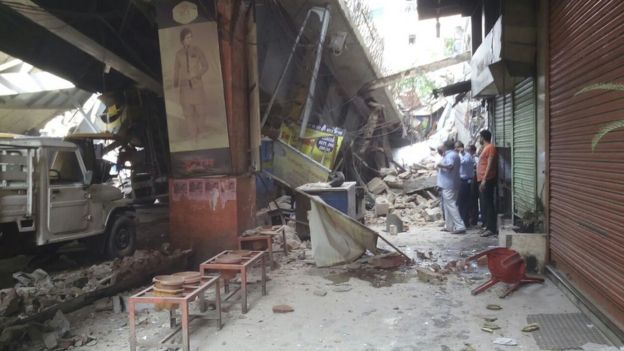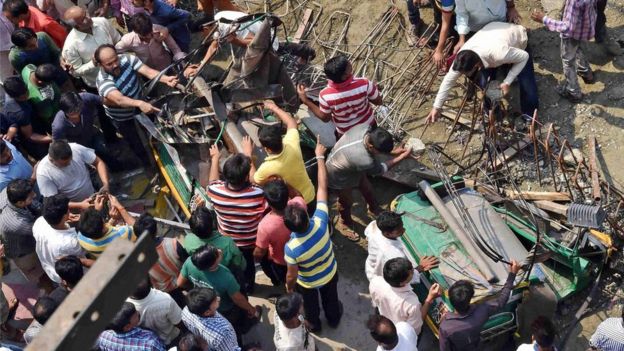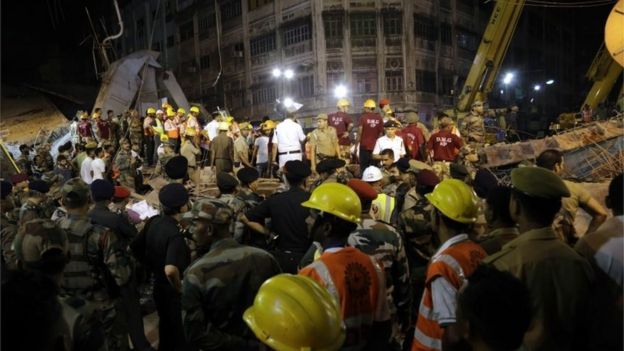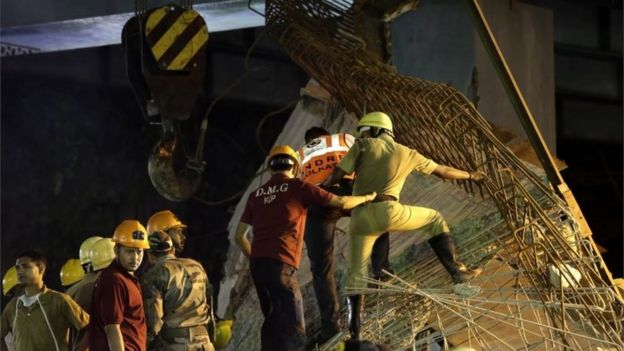India Kolkata flyover collapse: Hope fading for survivors
BBC
Hopes of finding more survivors trapped under a collapsed flyover are fading in the Indian city of Kolkata (Calcutta).
Rescuers have worked through the night in the Girish Park area, where the bypass was under construction when it collapsed suddenly on Thursday afternoon.
At least 24 people were killed and scores injured.
The 2km-long (1.2 mile) flyover started construction in 2009 and missed several deadlines for completion.
Police have opened a case of culpable homicide against the company in charge of the construction, IVRCL.
Reports say five of the firm’s officials have been detained for questioning and its headquarters in the southern Indian city of Hyderabad have been sealed off.
The company said it would co-operate with investigators. However one of its senior officials said in a news conference that the collapse had been “an act of god” as the company had a good safety record.
 Image copyright: Debasish Bhaduri
Image copyright: Debasish BhaduriImage caption: A section of the structure about 100m long fell suddenly on to traffic

 Image copyright: AP
Image copyright: APImage caption: Volunteers initially used bare hands to try to reach people trapped under the rubble
–
Officials said more than 90 people have been rescued, some of whom are in hospital in a critical condition.
“Many of the people rescued have been seriously injured,” police chief Ajay Tyagi told the Reuters news agency.
“Many could still be buried below the debris.”
SS Guleria of India’s National Disaster Response Force told the Associated Press that the rescue operation was in its “last stage” and that “there is no possibility of finding any person alive”.
It is not clear how many people may be still trapped under the debris.
At the scene – Justin Rowlatt, BBC News, Kolkata

–
This is one of the busiest parts of one of India’s busiest cities and all around are scenes that speak of the scale of the tragedy: a crushed and burnt motorcycle, the shattered remains of an auto-rickshaw, a discarded handbag and tattered banners of flapping fabric.
Volunteers hand out hot sweet tea and biscuits to rescue workers and gawkers alike. There is a buzz of curious excitement among the crowd that has gathered to watch the operation, but behind it is a growing fury.
What people want to know is why what should have been a fairly straightforward construction project ended in such terrible disaster. And with state elections just days away, it has become a political issue, not just here in Bengal but nationally as well.
People are asking why a construction company that had been blacklisted by other states was put in charge of the project. Was too much pressure being put on it to complete the work? Did it cut corners?
Meanwhile above the scene looms what remains of the overpass itself. The two great arms of steel that would have held the concrete roadway are slumped as if in hopeless resignation.
Rescue workers have struggled to get cranes and other machinery through the narrow and congested streets of Burrabazar area where the incident happened.
India’s collapsing building problem
The cause of the disaster was not immediately clear, but safety issues such as lack of inspections and the use of substandard materials have plagued construction projects in India.

 Image copyright: AP
Image copyright: APImage caption:Hundreds of police, soldiers and disaster officials worked through the night
 Image copyright:AP
Image copyright:APImage captionMangled steel could be seen sticking out of the collapsed concrete
A recurring tragedy
 Image copyright: AP___
Image copyright: AP___- August 2015: At least 11 people die after a building collapses near India’s western city of Mumbai
- July 2015: Five killed after a four-storey building collapses in Delhi
- April 2013: 74 people die after a high-rise residential building in Mumbai collapses
- June 2014: At least 10 people killed when a three-storey building in Delhi collapses
- June 2014: At least 60 people killed when a building collapses in a Chennai suburb
- November 2010: 69 killed and more than 80 injured in a collapse in Delhi
- September 2009: Chimney of a power plant in Chhattisgarh caves in, killing 40 people
